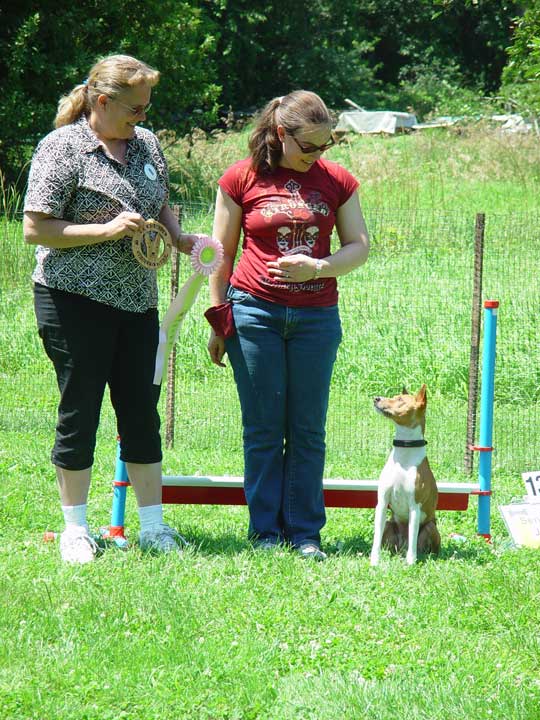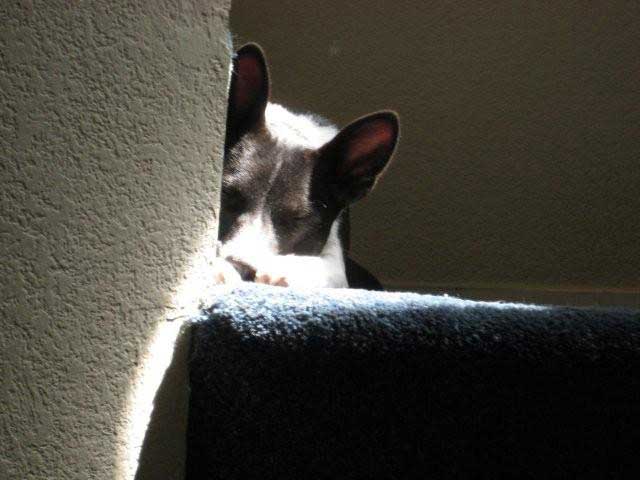Volume XIII, Issue 4, November 2009
Pages 12 & 13 next page
Round Robin
Training Conversation
November moderator: ![]() Andrea Stone, CCS
Andrea Stone, CCS

Why Don’t We Just Say No?
No! We all say it, don’t we? But there are many trainers who advise against saying it to our dogs. Why is that? Doesn’t that mean you’re letting him get away with things? How can he learn right from wrong if you don’t tell him?
There are several reasons saying, “No!” to your dog is unadvisable. None of it has to do with permissiveness or it being “mean” to tell your dog “no”.
* “No” comes with a lot of emotional baggage for us humans.
* We use “no” all the time and it loses saliency.
* It’s difficult to get the timing of “no” just right.
* “No” does not have inherent meaning to dogs.
* “No” is sometimes inadvertently reinforcing to the dog.
* “No” is not instructive.
![]() Lisa Voss
Lisa Voss
Why Don't We Just Say No?
I have found "No" just isn't effective. It does not work as a cue for a specific behavior because we use it when we want a whole range of behaviors.
"No, don't chew on the comforter." "No, don't jump on the table." "No, don't eat that old piece of meat you found in the bushes." "No, don't dig up the newly planted flowers."
No, doesn't provide enough information for the dog to know what you really want. We really mean things like Leave It and Off or we want to redirect their behavior. Which brings us to the other way No gets used which is as an interupter to stop a behavior so it can be redirected. My experience is that No isn't very good at getting my dogs' attention. I know they hear it but it doesn't result in a pause in their behavior so I can redirect. My dogs respond better to "ah, ah" which usually gets a head turn giving me the opportunity to redirect.
Another observation that seems to fit with this conversation is that the more you reward behavior you want, the less you see the behaviors you don't. Give them attention and treats when they are being calm. If they can get what they want laying around the house then that is what they will do. If they can't get your attention that way though, that is when they start thinking of ways to make you notice them.
It’s so much fun and really the dogs can’t go wrong. It’s low stress for the dog and relaxing for the handler – I don’t really even do anything but click and toss out food rewards (or whatever your dog may like). The cool thing is that with a really creative dog you can end up with a behavior that is entirely different from the one you’d envisioned but that’s okay; some of the funniest things my dogs do they thought of all by themselves!

![]() Sue Schulz
Sue Schulz
Saying "Yes" instead of saying "No, blah, blah. blah"
I believe positive results are products of our marking desired behavior. This can be a challenging endeavor, as we are so accustomed to taking notice when our dogs are not doing what we are hoping for. It is so easy to yell out, "No," to give that firm check on the training collar and a "No sniff"! We then follow with, "Good boy, nice, watch me, Heel". Gee whiz - with English as a second language, this can be very confusing for our dogs!
Let's get simple. Marking the desired behavior rather than taking note of all the accompaning actions will help your dog understand the result you are looking for. I like to use the word, "Yes" rather than a clicker. Why? Because I am a bit of a klutz and I just can't handle the leash, food and clicker? Well, I guess, but the real reason I like to use "Yes" is because it is word that is almost impossible to say without smiling.
When saying "Yes" it should be pitched so the dog understands it is special and not just more of "blah, blah blah". Key to use of marking desired behavior is use of a reward; food. When starting out, each time the marker is used the treat is given. Period. No misses. Eventually, the marker is used and time can be expanded between the marker and the treat - the marker becomes a bridge. The dog will understand the treat is coming.
Now when heeling with your dog as you step off and your dog steps off with you "Yes" will mark that behavior, along with a treat. As the dog looks up at you, or at your moving leg, another "Yes" and a treat. When the dog sniffs or pulls, change your direction and as the dog turns and looks he hears another "Yes" and gets a treat. Eventually commands of the exercise can be added, coupled with "Yes". Remember above where I mentioned saying "Yes" with a smile? If you have plans to compete in the ring, there is nothing more reassuring to your dog when he sees your smile. That has become his silent marker and he is getting positive signals from you that his treat is coming!
Positive marking leads to positive results, be it at home or out and about. It also leads to a very strong bond between you and your dog. Enjoy!
![]() Susan Kamen Marsicano
Susan Kamen Marsicano
Why Don't We Just Say No?
For a long time I said, “Phooey.” In the olden days when most used some sort of “I am not happy with you,” word. At least, I thought, “Phooey” makes me smile, so it’s not all that bad a thing to say. WELL, phooey got a rest and then simply disappeared, without me even noticing.
I realized how far “we” had come in thinking about dog training at a lure coursing trial in June. The nice Canadian judge came over. “ I have to tell you not to say “GO” to your dogs at the line. They’ll think you are saying, “NO,” and not run, or not run well. Oh boy, knowing this was an oft held thought at lure trials, and eons of training hours away from that thought, I battled for a clear sentence for her, maintaining a smile.
So, I said, “Thank you for your help, but, you see, I do agility with my dogs.”
“Aha?” the judge said.
I continued, seeing I had her attention, “and they do distance work, so they ‘know’ the word, ‘go,’ as in ‘GO Out!’.”
“Aha,” the judge said, more confidently, and off she went, I am sure, still thinking that my dogs with think I am saying “No,” when I say, “go.”
I left out explaining that we don’t say “No.” ![]() I don’t even like “leave it,” but that is for another training conversation
I don’t even like “leave it,” but that is for another training conversation
